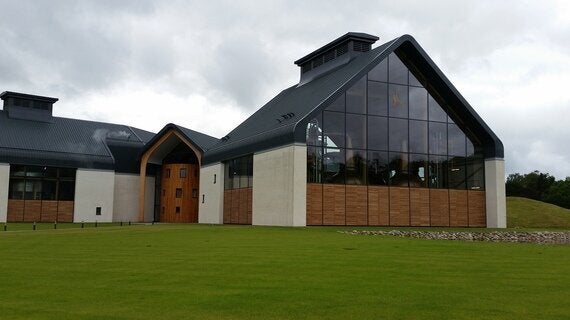French-owned Scotch whisky company Chivas Brothers has opened a stunning and eco-friendly Scotch whisky distillery between Knochando and Aberlour on the banks of the River Spey. The plant, which commenced production last September and was formally opened by Scotland's first minister Nicola Sturgeon in June, uses heat recovery technology to boost efficiency by 30 per cent compared to traditional plants.
And, unusually for what is essentially an industrial plant, the new distillery has won and been shortlisted for several of the UK's leading architectural awards. In addition to awards from RIBA and RIAS it has been shortlisted for the Stirling Prize.

Built on the site of the disused Imperial Distillery at Carron, the new Dalmunach distillery became the fifteenth Scotch whisky distillery operated by Chivas Brothers, which has been owned by Paris-based drinks multinational Pernod Ricard since 2000. The whisky business came into Pernod's fold as part of a joint $8.15bn carve-up takeover of the Seagram drinks empire from Franco-American entertainment conglomerate Vivendi Universal.
Chivas Brothers first briefed Inverness-based architects Archial Norr on the project in April 2012, with the main construction phase running from May 2013 to September 2014. Archial Norr director Mark Fresson, said: "Chivas Brothers wanted a building that would demonstrate the manufacturing process - from malt mills, to malt bins, to mash tuns, to washbacks, to stills, to the spirit safe - in a transparent and simple to follow way."
Fresson said Douglas Cruickshank, the project's champion at Chivas Brothers, made clear Chivas was not interested in another "big shed". Cruickshank had a strong emotional bond with the site. Having commenced work at the former Imperial Distillery at the age of 15, he went on to work for Chivas under consecutive owners including Distillers Company Ltd, Allied Domecq and Seagram, latterly as production director.
Chivas says the layout of the new distillery, which cost around £30m build, was modelled on the shape of a sheaf of barley, Scotch whisky's core ingredient. The building, which includes white, rendered walls and gable walls of glass, contains a mash house and still house, a cooling-water intake and discharge system, an evaporator building, and a bio-plant building. Intricate civil engineering works, including a sump to draw water out of the adjacent River Spey, formed a significant part of the project.
The production plant's glass-fronted still room houses eight copper pot stills, with tulip shapes used for the wash stills and onion shapes used for the spirit stills, replicating those used at the Imperial Distillery. In a departure from distillery tradition, the stills are arranged in a circular pattern, which gives an unusual feeling of spaciousness in the still room.
Archial also recycled certain features of the former Imperial Distillery and incorporated them into the Dalmunach's design.
Showing guests around the new plant on opening day. Chivas operations manager Trevor Buckley said: "All the cooling water, 400,000 litres per hour, comes from the River Spey. The thermal vapour recompression technology [on the spirit condensers] makes this one of the most efficient distilleries in the world." He added that the new distillery is capable of running 46 weeks a year, with six weeks set aside for maintenance and cleaning.
Buckley said that Dalmunach's annual output of ten million litres of alcohol per year makes it the second highest capacity distillery that Chivas owns, just behind The Glenlivet, which produces 10.5m litres a year. He said the style of spirit produced at Dalmunach suits blends including Chivas Regal and Ballantines. "It's a very, very floral fruity spirit," said Buckley. Production started in September 2014, nine months before it was formally opened.
Opening the plant Sturgeon hailed the facility as a "real vote of confidence" in the Scotch whisky sector. "The Dalmunach Distillery is one of 115 across Scotland and it is a sign of continued investment from Chivas Brothers. It's also fitting that this facility opens in the Year of Food and Drink."
Some commentators have questioned the wisdom of opening a new distillery at a time when exports of Scotch whisky have gone into reverse. Overall Scotch sales were down 7.4 per cent to £3.94bn last year, the second annual decline in a row and the biggest fall since 1998. The slump in sales - exacerbated by China's anti-corruption drive and the Eurozone crisis - has reawakened memories of past whisky sector downturns, including the notorious "whisky loch", which was caused by over-production and under-pricing the 1970s.
But Pernod Ricard's top brass are unfazed. "Our confidence in the long-term growth prospects for the category remains strong," said Chivas Brothers chairman and chief executive Laurent Lacassagne. "The construction of the new Dalmunach distillery is a clear demonstration of our confidence and also of our commitment to invest to meet the significant growth potential."
There are more than 20 other distilleries in a five-mile radius of the site, the majority of which are owned by overseas multinationals. They include Bacardi's Craigellachie; Campari's Glen Grant; Chivas Brothers's Aberlour and The Glenlivet; Diageo's Cardhu, Dailuaine and Knockando; Edrington's The Macallan; Ian MacLeod's Tamdhu; J&G Grant's Glenfarclas; and Whyte & Mackay's Tamvulin.
The Imperial Distillery, which occupied the site from 1897 to 2012 is dubbed "the unlucky distillery" by industry insiders because it only ever operated sporadically, partly due to oversupply issues in the industry.